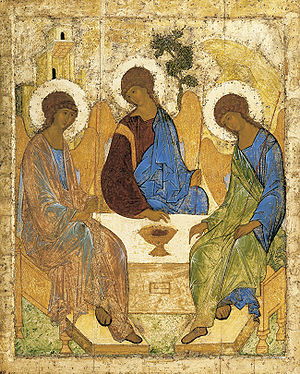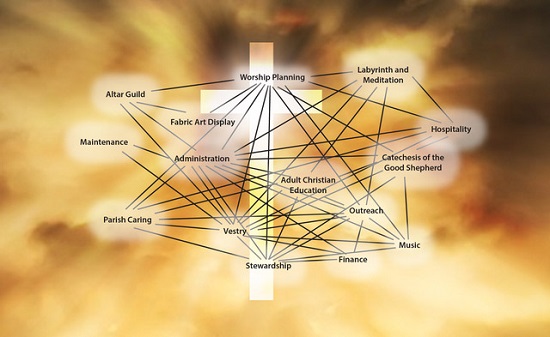Collaborative Ministry Model at St. Peter's
History
This ministry model began with a vision to empower and nurture lay (and clergy) leadership with plans – in time – to reduce the rector’s hours. (It is also helpful to remember that it was preceded by such endeavours as: (1) a book study, ‘Changing the Conversation’ [Anthony Robinson], (2) an intense [and collaborative] process for developing purpose and vision statements, along with solid and ongoing commitment to use the statements as a framework for ministries, vestry agendas, etc. The collaborative ministry model was the logical result of years of preliminary work.
It began with a parish study focused on the theory of collaboration. Rooted in a focus on Rublev’s Holy Trinity icon, this shaped our view of what collaboration actually looks like.

This includes important qualities such as, a willingness to see all ministries as interdependent and work cooperatively accordingly; a commitment to the ‘success’ of the group rather than of the individual; a willingness to amicably share on the level of ideas. Reflections on Rublev’s icon identify this collaborative culture.
In addition to this foundational source, those who attended this study engaged in a book review: Collaboration: Uniting Our Gifts in Ministry (Loughlan Sofield, S.T., and Carroll Juliano, S.H.C.J.) This is an excellent resource in terms of the theory of collaboration, and is further substantiated in Harvard Business Review’s series of articles ‘On Collaboration.’
With such intentionality and designated ministries receiving focused attention and leadership, a burst of energy was unleashed, resulting in a renewed commitment to maintain a full time incumbent. Therefore the initial vision to reduce the rector’s hours shifted, redefining rather than reducing her responsibilities.
In January this year parish leadership engaged in a review of collaborative ministry at St. Peter’s, which provided the necessary framework for revisions that were presented at the AGM in February.
Challenges and opportunities going forward: (1) St. Peter’s looks forward to this model evolving over time, as it has thus far [a new member to the team – i.e., new incumbent – automatically shifts the dynamics, through which God’s creative hand will likely generate new possibilities]; (2) sharing gifts in ministry will always shift, depending on the gifts available at any given time, so it is important to discern ministries accordingly [e.g. at the moment, with an abundance of theologically educated disciples at St. Peter’s, there is room for a theological advisor role, and this may not always be the case… and that’s O.K. too]; (3) there is work yet to be done in terms of identifying and sharing gifts for ministry, so that the leadership circle continues to grow.
Collaboration at St. Peter’s
This rootedness in the relationship of love and mutuality that flows within the Trinity, calls us into creation to love, heal, and restore. By our baptism we participate in that divine life and mission.
As defined in our Book study, “Collaboration is the identification, release, and union of all the gifts in ministry for the sake of the mission of Jesus Christ.” All the baptized are given gifts for ministry. Therefore, collaboration at St. Peter’s includes:
- Discernment and affirmation of each person’s gifts, and where and how they are called to exercise those gifts
- Shared leadership and decision-making
- Extensive consultation and communication regarding existing and possible new ministries (communication + cooperation = collaboration)
- Awareness that all ministry is interdependent
- Awareness that we share in God’s mission to heal and restore all of creation. It is not our mission, but God’s
Only as we engage in collaboration and interdependence will we truly begin to build the reign of God in this time and place.
From Pastors to Theological al Advisor
The team working closest with Donna since the inception of St. Peter’s collaborative ministry model had included Donna and leaders defined as pastors. During the past few months as Donna and the team have been reviewing St. Peter’s collaborative ministry model they have examined the role of our current pastors, and it became clear that a more accurate title for their role is ‘theological advisor’. That is, they are primarily responsible for helping St. Peter’s disciples reflect on how their ministries talk about God in word and action. This role includes:
St. Peter’s Theological Advisor
The role of theological advisor is to better ground St. Peter’s ministries theologically; that is, to ensure that they are rooted in and inspired by the teachings of our faith.
Broad Responsibilities:
- Discerning with individuals and the group where they feel called to do additional learning that will deepen a theological understanding of their ministry
- Discerning, as theological advisor, additional learning required by the group.
- Facilitating the group to take ownership for opening and closing prayers
- In the context of meeting discussions, to be ready to offer a theological perspective.
- Responsibilities related to specific ministries
- Work collaboratively with chairperson and other ministries
- Meet bi-monthly with incumbent and other T.A.’s; on alternate months this team will meet with corporation.
At the moment, we will refer to Shelagh, Rod, and Mary as theological advisors. Although such assignments are continually evolving, currently they are serving as T.A.’s in Outreach Ministry Team, Adult Christian Education, and Parish Caring Ministries. This change requires each team/committee to appoint a chairperson who will work collaboratively with this advisor. This role will include:
St. Peter’s Chairpersons
Broad Responsibilities
- Call meetings
- Set the agenda
- Chair the meeting
- Facilitate discussion
- Assign responsibility for action to be taken
- Encourage and promote the ministry (capture enthusiasm)
- Work collaboratively with theological advisor and other ministries
Discerning, Releasing, and Uniting Gifts for Ministry
In order to allow collaborative ministry to further take root in St. Peter’s, more intentional discernment of gifts for ministry is required. This will be facilitated by the formation of a ‘Discernment of Gifts’ Team. Corporation and Theological Advisors will be responsible for establishing this team. This role will include:
Discernment of Gifts Team
Broad Responsibilities
- Meet with all new members to explore their interests and passions
- Provide opportunities for all parish members to explore their interests and passions
- Help align people with existing ministries at St. Peter’s
- Help people discern new ministries that align with their interests and passions
- Work collaboratively with parish leadership to facilitate the development of potential new ministries.
Silos vs. Interconnectedness

Probably the biggest surprise in this journey toward intentional collaboration is the paradigmatic shift from silos to interdependence. We have discovered at a whole new level how deeply embedded the silo model is within the context of Anglican polity, in general.

Work over the past five years has begun a process, leading to a model of interdependence. It is a process and while much progress has been made, it remains a work-in-progress. As we engage in this journey we are often reminded that paradigm shifts take time.

